Saturday, 15 June, Danish painting at the Jacquemart-Andrée and stood up for dinner
Written 18 June 2019
On the docket for Saturday was a trip to the Jacquemart-André Museum to see the special exhibition on Vilhelm Hammershøi (1864–1916), the master of Danish painting. I had prepurchased tickets with a 10:30 a.m. entry time, so David dragged himself out of bed at what he considers an ungodly hour (about 9:30, I think), and we hopped the #43 bus just down the block, at "Église St. Ferdinand," and got off at "Haussman-Courcelles," right across the street from the museum. Of course, we had to cross a four-lane boulevard without a light or crosswalk, but traffic was light . . .

 Hammershøi said he chose his subjects primarily for their "structure," the arrangement of vertical and horizontal lines in the scene, and then for the play of light. By others he is described as a painter of silence and light, and the works you see here, an early portrait of his future wife on the left and on the right a portrait of four men (close friends from the art world), plus his own brother smoking a pipe in the foreground, are about as colorful as he gets, and the five portraits are characteristic of his works—the men don't interact or speak; they sit in silence.
Hammershøi said he chose his subjects primarily for their "structure," the arrangement of vertical and horizontal lines in the scene, and then for the play of light. By others he is described as a painter of silence and light, and the works you see here, an early portrait of his future wife on the left and on the right a portrait of four men (close friends from the art world), plus his own brother smoking a pipe in the foreground, are about as colorful as he gets, and the five portraits are characteristic of his works—the men don't interact or speak; they sit in silence.
I suspect my friend Françoise Favre would say that his work confirms her opinion of Denmark— she taught there for a year and has nothing good to say about it. It was dark, dreary, rainy, gray, grim etc.
<

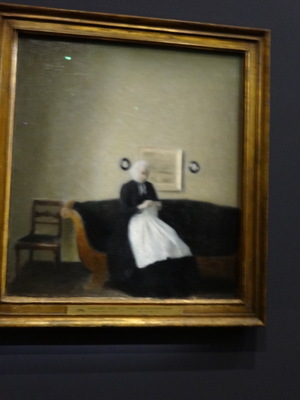 The artist was a great admirer of Whistler and went so far as to paint his own mother in a similar pose (shown here at the left with a small photo of Whistler's mother for comparison. Later he painted his mother knitting, shown here at the right.
The artist was a great admirer of Whistler and went so far as to paint his own mother in a similar pose (shown here at the left with a small photo of Whistler's mother for comparison. Later he painted his mother knitting, shown here at the right.
Written 19 June 2019
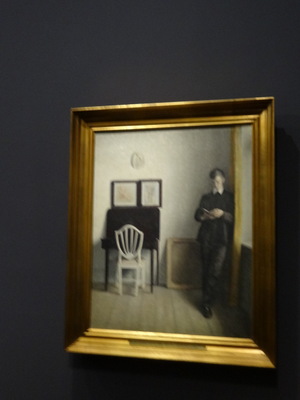
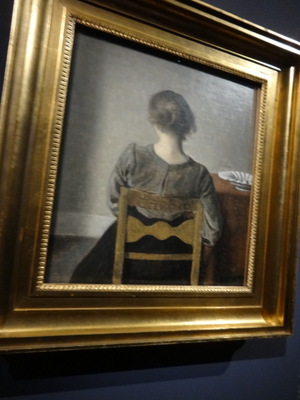 Hammershøi was primarily a painter of interiors, but never of intimate scenes. At the left here is another protrait of his brother, but again, the subject does not interact with the viewer or even the room. But he's another vertical element in this composition based on verticals.
Hammershøi was primarily a painter of interiors, but never of intimate scenes. At the left here is another protrait of his brother, but again, the subject does not interact with the viewer or even the room. But he's another vertical element in this composition based on verticals.
At the left, the female figure (Hvile, the painter's sister-in-law maybe?) again has no intereactions with anyone, but by Hammershøi standards, the scene is positively action-filled—the subtitle is "Repose," and the figure is leaning back against the chair. Something is almost happening!

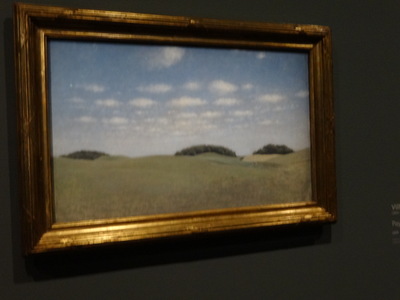 Hammershøi didn't have much interest in landscapes, but he painted a few. The commentary provided by the exhibitios curator points out that he managed to turn his later landscapes into interiors and I can sort of see his point.
Hammershøi didn't have much interest in landscapes, but he painted a few. The commentary provided by the exhibitios curator points out that he managed to turn his later landscapes into interiors and I can sort of see his point.
The painting at the left is one he did as a young student, and in it he follows all the conventions he was being taught. He uses color, and the line of trees leads the viewer's eye into the distance, lending depth to the view.
In the one on the right, and in the several other landscapes in the exhibition, the horizon forms a back wall; it's a composition of horizontals. He must have been struck by the way the clouds line up in horizontal rows.

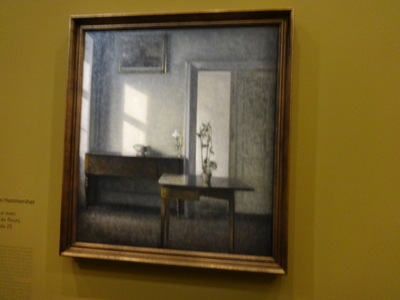 In his later works, he didn't even bother to put people in his interiors. What interested him was the lines and planes and the play of light on them. He especially liked the way shafts of light interacted with the flat and straight structures.
In his later works, he didn't even bother to put people in his interiors. What interested him was the lines and planes and the play of light on them. He especially liked the way shafts of light interacted with the flat and straight structures.
At the left here, light filters in through an open door, and we have a view of another door beyond (I think the painting's title is actually "the door").
In the one at the right (slightly out of focus, I'm afraid), a shaft of light from a window illuminates the scene, and a rather bedraggled (but vertical!) potted orchid is framed in an open doorway.
I found that what Hammershøi's paintings most reminded me of was a series of works by Dan Ohlmann, the genius miniaturist based in Lyon. He makes many miniatures for museums or for use in movie special effects, but when he just makes them as art, one of his favorite subjects is large, deserted interior spaces illuminated by shafts of light. I remember particularly the interior of a derelict theater and another of an old ballet practice studio up under the roof of an opera house. They are stunningly realistic, and he even conveys the illusion of dust motes hanging in the light. And they convey exactly the strong impression of silence that Hammershøi evokes. Check out Ohlmann's website (https://www.museeminiatureetcinema.fr/en/) to view some of them.
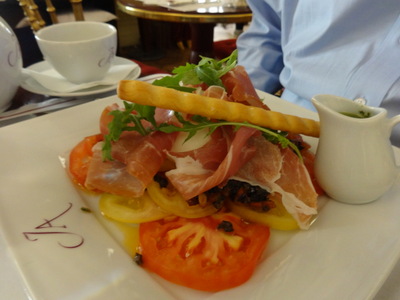
 As I've mentioned in other diaries, the Jacquemart-André boasts about the best museum lunch room going—only the one at the Musée d'Orsay gives it any competition. Once we'd seen the whole temporary exhibition, we broke for lunch there.
As I've mentioned in other diaries, the Jacquemart-André boasts about the best museum lunch room going—only the one at the Musée d'Orsay gives it any competition. Once we'd seen the whole temporary exhibition, we broke for lunch there.
David ordered the Ucello salad (new this year on the menu), which consisted of a layer of sliced red and yellow tomatoes, a burrata, a few sprigs of arugula, slices of raw ham, and a mixture of diced alives, tomatoes, and pine nuts. Bright green sauce on the side (pesto maybe?), and a long crunchy breadstick laid across the top.
I had planned to go back to the Vigée-Lebrun salad this year, but the "guest" salad (they always create one in honor of the artist featured in the temporary exhibition) looked good, so I ordered the Hammershøi: mixed baby greens, boiled potatoes, marinated raw salmon chunks, smoked herring, chioga beets, agurkesalat (sweet cucumber pickles), syltede rødbeder (sweet pickled beets), dill. Vinaigrette of peanut oil, egg, and minced herring. It was delicious, and I hope visiting Danes didn't think it silly. As I recall, last year's "Marie Cassatt" involved BBQ sauce (she was American, you see).

 From the dessert trolley, David chose the mille-feuilles (what Americans call a Napoleon), and I got a wedge of Paris-Brest (cream-puff pastry filled and topped with hazelnut cream), both entirely satisfactory.
From the dessert trolley, David chose the mille-feuilles (what Americans call a Napoleon), and I got a wedge of Paris-Brest (cream-puff pastry filled and topped with hazelnut cream), both entirely satisfactory.

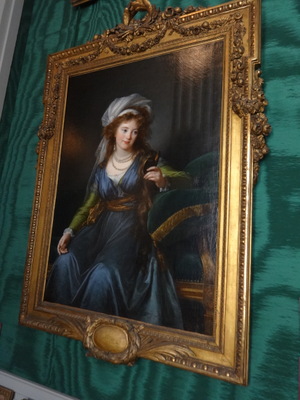 After lunch, we took a turn back through the permanent collection. I had forgotten about the novel horizontal-form clock shown here at the left.
After lunch, we took a turn back through the permanent collection. I had forgotten about the novel horizontal-form clock shown here at the left.
At the right is a protrait of La Comtesse Catherine Skavronskaïa (ca. 1790) by Elizabeth Vigée-Lebrun (1755–1842).
The #43 bus then took us home again (this time without the hazardous street crossing, to rest up before our scheduled dinner.
For Saturday, David chose a restaurant called Hexagone from the G-M guide (news media in France often refer to the country as "the hexagon"), but when I went to make reservations there, I found they'd changed their name to Masha. Okay, whatever; the menu still looked good, though more heavily Asian influenced. On Saturday night, we were running late (misjudged the Saturday bus schedule) and were all set to apologize for being seven minutes late for our 8:00 p.m. reservation. Imagine our annoyance at presenting ourselves once again before a locked door. No lights inside this time, and the hanging tendrils on the vine-covered outside wall had almost obscured the "Masha" sign. The view through the glass doors was only of the back of a curtain. Peering in through a sidelight, I could see tables stacked in a darkened room. Drat.
We drummed our figurative fingers for a few minutes before concluding that once again a restaurant had folded up on us since we made our reservation. We therefore walked the half a block to the Place du Trocadero, facing the Eiffel Tower across the Seine. It's not the most touristy square in Paris, but it's definitely in the top 10 and probably the top 5. We strolled around the periphery, reading the menus of the half a dozen restaurants lined up side by side, before settling back at the first we looked at, Le Coq.
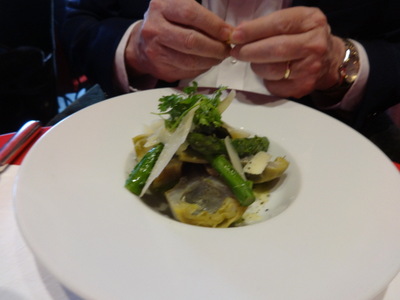
 David started with a plate of artichokes and asparagus, topped with vinaigrette and Parmesan flakes. He said the asparagus was great, but the artichokes were not his favorite. He was drinking a white wine, and artichokes always fight with wine (and, in fact, with everything, according to David).
David started with a plate of artichokes and asparagus, topped with vinaigrette and Parmesan flakes. He said the asparagus was great, but the artichokes were not his favorite. He was drinking a white wine, and artichokes always fight with wine (and, in fact, with everything, according to David).
I decided to go with all clichés, all the time, and started with half a dozen snails. As it happens, they were very good. The strange bouquet of antennae sticking up out of the center were long skinny strips of toast, presumably intended for dipping into the garlic-parsley butter left in the shells after the snails were extracted (with a special small fork provided for the purpose), but they didn't work very well that way. I found it much easier to put torn pieces of bread on the plate, pour the butter onto them, and then eat them with a fork.
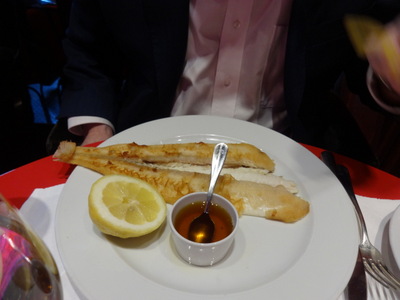
 David's main course was sole. As you can see, they floured and pan-fried the fish, then parted the top layer along the lateral line and spread it enough to extract the anterior two-thirds of the skeleton. Olive oil and lemon on the side. He said it was just a pan-fried fish—nothing special.
David's main course was sole. As you can see, they floured and pan-fried the fish, then parted the top layer along the lateral line and spread it enough to extract the anterior two-thirds of the skeleton. Olive oil and lemon on the side. He said it was just a pan-fried fish—nothing special.
I continued my theme by ordering a medium-rare rib-eye, which came with fries (in other words, "steak-frites"). The steak was great. It came with a little pot of stewed sliced peppers, which I tasted, wiped my eyes, which were streaming, and then left strictly alone. The fries were okay, at least once we got our rather scattered waitress to concentrate long enough to bring us the mayo we requested.
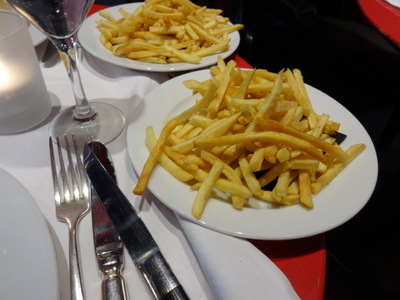
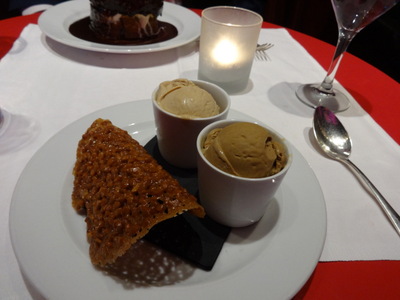 David got fries, too, so we wound up with plenty.
David got fries, too, so we wound up with plenty.
For dessert, I ordered ice cream—one ball each hazelnut and coffee—factory-made tuile cookie on the side. I'd have said there was no such thing as a too-strongly-flavored coffee ice cream, but this was it. Almost as cloying as chocolate. The hazelnut was better, but both had a very disagreeable mouth feel, like eating flannel. Too bad; French ice cream is usually pretty reliable.
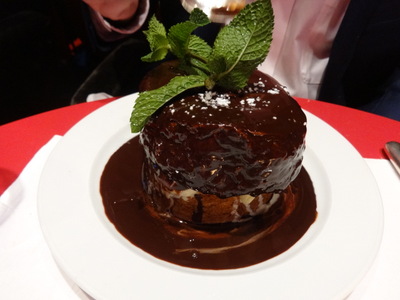 David likes profiteroles and one of the desserts listed on the menu was "une tres belle profiterole" (literally "a very beautiful profiterole," but more idiomatically, "one fine profiterole"). One was delivered to the table behind him while we ate, and I remarked with astonishment that it was as big as his head! He nevertheless ordered it, and was presented with (to the glee of the waiter who brought it) this monster—fully six inches in diameter by six inches high, stuffed with about a pint of vanilla ice cream, doused with chocolate sauce, and topped with a good-sized branch of mint.
David likes profiteroles and one of the desserts listed on the menu was "une tres belle profiterole" (literally "a very beautiful profiterole," but more idiomatically, "one fine profiterole"). One was delivered to the table behind him while we ate, and I remarked with astonishment that it was as big as his head! He nevertheless ordered it, and was presented with (to the glee of the waiter who brought it) this monster—fully six inches in diameter by six inches high, stuffed with about a pint of vanilla ice cream, doused with chocolate sauce, and topped with a good-sized branch of mint.
He started by removing the mint and cutting it in half, then managed to finish one of the halves before declaring a victory and calling home the troops.
Previous entry
List of Entries
Next entry

 Hammershøi said he chose his subjects primarily for their "structure," the arrangement of vertical and horizontal lines in the scene, and then for the play of light. By others he is described as a painter of silence and light, and the works you see here, an early portrait of his future wife on the left and on the right a portrait of four men (close friends from the art world), plus his own brother smoking a pipe in the foreground, are about as colorful as he gets, and the five portraits are characteristic of his works—the men don't interact or speak; they sit in silence.
Hammershøi said he chose his subjects primarily for their "structure," the arrangement of vertical and horizontal lines in the scene, and then for the play of light. By others he is described as a painter of silence and light, and the works you see here, an early portrait of his future wife on the left and on the right a portrait of four men (close friends from the art world), plus his own brother smoking a pipe in the foreground, are about as colorful as he gets, and the five portraits are characteristic of his works—the men don't interact or speak; they sit in silence.
 The artist was a great admirer of Whistler and went so far as to paint his own mother in a similar pose (shown here at the left with a small photo of Whistler's mother for comparison. Later he painted his mother knitting, shown here at the right.
The artist was a great admirer of Whistler and went so far as to paint his own mother in a similar pose (shown here at the left with a small photo of Whistler's mother for comparison. Later he painted his mother knitting, shown here at the right.
 Hammershøi was primarily a painter of interiors, but never of intimate scenes. At the left here is another protrait of his brother, but again, the subject does not interact with the viewer or even the room. But he's another vertical element in this composition based on verticals.
Hammershøi was primarily a painter of interiors, but never of intimate scenes. At the left here is another protrait of his brother, but again, the subject does not interact with the viewer or even the room. But he's another vertical element in this composition based on verticals.

 Hammershøi didn't have much interest in landscapes, but he painted a few. The commentary provided by the exhibitios curator points out that he managed to turn his later landscapes into interiors and I can sort of see his point.
Hammershøi didn't have much interest in landscapes, but he painted a few. The commentary provided by the exhibitios curator points out that he managed to turn his later landscapes into interiors and I can sort of see his point.
 In his later works, he didn't even bother to put people in his interiors. What interested him was the lines and planes and the play of light on them. He especially liked the way shafts of light interacted with the flat and straight structures.
In his later works, he didn't even bother to put people in his interiors. What interested him was the lines and planes and the play of light on them. He especially liked the way shafts of light interacted with the flat and straight structures.
 As I've mentioned in other diaries, the Jacquemart-André boasts about the best museum lunch room going—only the one at the Musée d'Orsay gives it any competition. Once we'd seen the whole temporary exhibition, we broke for lunch there.
As I've mentioned in other diaries, the Jacquemart-André boasts about the best museum lunch room going—only the one at the Musée d'Orsay gives it any competition. Once we'd seen the whole temporary exhibition, we broke for lunch there.
 From the dessert trolley, David chose the mille-feuilles (what Americans call a Napoleon), and I got a wedge of Paris-Brest (cream-puff pastry filled and topped with hazelnut cream), both entirely satisfactory.
From the dessert trolley, David chose the mille-feuilles (what Americans call a Napoleon), and I got a wedge of Paris-Brest (cream-puff pastry filled and topped with hazelnut cream), both entirely satisfactory.
 After lunch, we took a turn back through the permanent collection. I had forgotten about the novel horizontal-form clock shown here at the left.
After lunch, we took a turn back through the permanent collection. I had forgotten about the novel horizontal-form clock shown here at the left. 
 David started with a plate of artichokes and asparagus, topped with vinaigrette and Parmesan flakes. He said the asparagus was great, but the artichokes were not his favorite. He was drinking a white wine, and artichokes always fight with wine (and, in fact, with everything, according to David).
David started with a plate of artichokes and asparagus, topped with vinaigrette and Parmesan flakes. He said the asparagus was great, but the artichokes were not his favorite. He was drinking a white wine, and artichokes always fight with wine (and, in fact, with everything, according to David).
 David's main course was sole. As you can see, they floured and pan-fried the fish, then parted the top layer along the lateral line and spread it enough to extract the anterior two-thirds of the skeleton. Olive oil and lemon on the side. He said it was just a pan-fried fish—nothing special.
David's main course was sole. As you can see, they floured and pan-fried the fish, then parted the top layer along the lateral line and spread it enough to extract the anterior two-thirds of the skeleton. Olive oil and lemon on the side. He said it was just a pan-fried fish—nothing special.
 David got fries, too, so we wound up with plenty.
David got fries, too, so we wound up with plenty. David likes profiteroles and one of the desserts listed on the menu was "une tres belle profiterole" (literally "a very beautiful profiterole," but more idiomatically, "one fine profiterole"). One was delivered to the table behind him while we ate, and I remarked with astonishment that it was as big as his head! He nevertheless ordered it, and was presented with (to the glee of the waiter who brought it) this monster—fully six inches in diameter by six inches high, stuffed with about a pint of vanilla ice cream, doused with chocolate sauce, and topped with a good-sized branch of mint.
David likes profiteroles and one of the desserts listed on the menu was "une tres belle profiterole" (literally "a very beautiful profiterole," but more idiomatically, "one fine profiterole"). One was delivered to the table behind him while we ate, and I remarked with astonishment that it was as big as his head! He nevertheless ordered it, and was presented with (to the glee of the waiter who brought it) this monster—fully six inches in diameter by six inches high, stuffed with about a pint of vanilla ice cream, doused with chocolate sauce, and topped with a good-sized branch of mint.